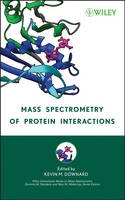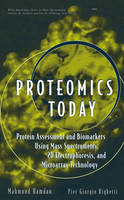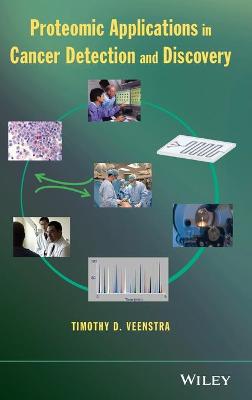Mass Spectrometry of Protein Interactions
 -15%
portes grátis
-15%
portes grátis
Mass Spectrometry of Protein Interactions
Downard, Kevin
John Wiley & Sons Inc
08/2007
152
Dura
Inglês
9780471793731
15 a 20 dias
392
Descrição não disponível.
Preface. Contributors.
Chapter 1. Direct Characterization of Protein Complexes by Electrospray Ionization Mass Spectrometry and Ion Mobility Analysis (Joseph A. Loo and Catherine S. Kaddis).
1.1 Introduction.
1.2 Critical Aspects of the Experimental Procedure.
1.3 Solution Phase Equilibria and Gas Phase Dissociation.
1.4 Conclusions.
Chapter 2. Softly, Softly-Detection of Protein Complexes by Matrix-Assisted Laser Desorption Ionisation Mass Spectrometry (Kevin M. Downard).
2.1 Introduction.
2.2 First Glimpses and the First-Shot Phenomenon.
2.3 Matrix and Solution Criteria to Preserve Protein Complexes.
2.4 Laser Fluence, Wavelength and Ion Extraction.
2.5 Preservation of Protein Complexes on Conventional Maldi Targets.
2.6 Affinity Targets and Surfaces Coupled To Maldi.
2.7 Conclusions.
Chapter 3. Probing Protein Interactions Using Hydrogen-Deuterium Exchange Mass Spectrometry (David D. Weis, Suma Kaveti, Yan Wu and John R. Engen).
3.1 Introduction.
3.2 Hydrogen Exchange Background.
3.3 General HX-MS Method.
3.4 Interactions of Proteins.
3.5 Examples.
3.6 Conclusions.
Chapter 4. Limited Proteolysis Mass Spectrometry of Protein Complexes (Maria Monti and Piero Pucci).
4.1 Introduction.
4.2 Limited Proteolysis Analysis.
4.3 Experimental Design.
4.4 Probing Protein-Protein Interactions.
4.5 Probing Protein-Nucleic Acid Interactions.
4.6 Protein-Ligand Interactions.
4.7 Probing Amyloid Fibril Core.
4.8 Conlusions.
Chapter 5. Chemical Cross-Linking and Mass Spectrometry for Investigation of Protein-Protein Interactions (Andrea Sinz).
Introduction.
5.1 Cross-Linking Strategies.
5.2 Functional Groups of Cross-Linking Reagents.
5.3 Mass Spectrometric Analysis of Cross-Linked Products.
5.4 Identification of Cross-Linked Produc.
5.5 Computer Software for Data Analysis.
5.6 Conclusions and Perspectives.
Chapter 6. Genesis & Application of Radical Probe Mass Spectrometry (RP-MS) to Study Protein Interactions (Simin D. Maleknia and Kevin M. Downard).
6.1 Genesis of Radical Probe Mass Spectrometry.
6.2 The Reactive Residue Side Chains.
6.3 Conditions Important to Radical Probe Mass Spectrometry Experiments.
6.4 Generation of Radicals on Millisecond Timescales.
6.5 Applications of RP-MS to Studies of Protein Interactions.
6.6 Onset of Oxidative Damage and Its Implications for Protein Interactions.
6.7 Application of Radical Oxidation to Study Protein Assemblies.
6.8 Modeling Protein Complexes with Data from RP-MS Experiments.
6.9 Conclusions.
Index.
Chapter 1. Direct Characterization of Protein Complexes by Electrospray Ionization Mass Spectrometry and Ion Mobility Analysis (Joseph A. Loo and Catherine S. Kaddis).
1.1 Introduction.
1.2 Critical Aspects of the Experimental Procedure.
1.3 Solution Phase Equilibria and Gas Phase Dissociation.
1.4 Conclusions.
Chapter 2. Softly, Softly-Detection of Protein Complexes by Matrix-Assisted Laser Desorption Ionisation Mass Spectrometry (Kevin M. Downard).
2.1 Introduction.
2.2 First Glimpses and the First-Shot Phenomenon.
2.3 Matrix and Solution Criteria to Preserve Protein Complexes.
2.4 Laser Fluence, Wavelength and Ion Extraction.
2.5 Preservation of Protein Complexes on Conventional Maldi Targets.
2.6 Affinity Targets and Surfaces Coupled To Maldi.
2.7 Conclusions.
Chapter 3. Probing Protein Interactions Using Hydrogen-Deuterium Exchange Mass Spectrometry (David D. Weis, Suma Kaveti, Yan Wu and John R. Engen).
3.1 Introduction.
3.2 Hydrogen Exchange Background.
3.3 General HX-MS Method.
3.4 Interactions of Proteins.
3.5 Examples.
3.6 Conclusions.
Chapter 4. Limited Proteolysis Mass Spectrometry of Protein Complexes (Maria Monti and Piero Pucci).
4.1 Introduction.
4.2 Limited Proteolysis Analysis.
4.3 Experimental Design.
4.4 Probing Protein-Protein Interactions.
4.5 Probing Protein-Nucleic Acid Interactions.
4.6 Protein-Ligand Interactions.
4.7 Probing Amyloid Fibril Core.
4.8 Conlusions.
Chapter 5. Chemical Cross-Linking and Mass Spectrometry for Investigation of Protein-Protein Interactions (Andrea Sinz).
Introduction.
5.1 Cross-Linking Strategies.
5.2 Functional Groups of Cross-Linking Reagents.
5.3 Mass Spectrometric Analysis of Cross-Linked Products.
5.4 Identification of Cross-Linked Produc.
5.5 Computer Software for Data Analysis.
5.6 Conclusions and Perspectives.
Chapter 6. Genesis & Application of Radical Probe Mass Spectrometry (RP-MS) to Study Protein Interactions (Simin D. Maleknia and Kevin M. Downard).
6.1 Genesis of Radical Probe Mass Spectrometry.
6.2 The Reactive Residue Side Chains.
6.3 Conditions Important to Radical Probe Mass Spectrometry Experiments.
6.4 Generation of Radicals on Millisecond Timescales.
6.5 Applications of RP-MS to Studies of Protein Interactions.
6.6 Onset of Oxidative Damage and Its Implications for Protein Interactions.
6.7 Application of Radical Oxidation to Study Protein Assemblies.
6.8 Modeling Protein Complexes with Data from RP-MS Experiments.
6.9 Conclusions.
Index.
Este título pertence ao(s) assunto(s) indicados(s). Para ver outros títulos clique no assunto desejado.
guide; role; increasingly important; ms; mass spectrometry; authoritative; interactions; range; timely; approaches; diverse; protein interactionspresents; definitive discussions; international; fields; authorities
Preface. Contributors.
Chapter 1. Direct Characterization of Protein Complexes by Electrospray Ionization Mass Spectrometry and Ion Mobility Analysis (Joseph A. Loo and Catherine S. Kaddis).
1.1 Introduction.
1.2 Critical Aspects of the Experimental Procedure.
1.3 Solution Phase Equilibria and Gas Phase Dissociation.
1.4 Conclusions.
Chapter 2. Softly, Softly-Detection of Protein Complexes by Matrix-Assisted Laser Desorption Ionisation Mass Spectrometry (Kevin M. Downard).
2.1 Introduction.
2.2 First Glimpses and the First-Shot Phenomenon.
2.3 Matrix and Solution Criteria to Preserve Protein Complexes.
2.4 Laser Fluence, Wavelength and Ion Extraction.
2.5 Preservation of Protein Complexes on Conventional Maldi Targets.
2.6 Affinity Targets and Surfaces Coupled To Maldi.
2.7 Conclusions.
Chapter 3. Probing Protein Interactions Using Hydrogen-Deuterium Exchange Mass Spectrometry (David D. Weis, Suma Kaveti, Yan Wu and John R. Engen).
3.1 Introduction.
3.2 Hydrogen Exchange Background.
3.3 General HX-MS Method.
3.4 Interactions of Proteins.
3.5 Examples.
3.6 Conclusions.
Chapter 4. Limited Proteolysis Mass Spectrometry of Protein Complexes (Maria Monti and Piero Pucci).
4.1 Introduction.
4.2 Limited Proteolysis Analysis.
4.3 Experimental Design.
4.4 Probing Protein-Protein Interactions.
4.5 Probing Protein-Nucleic Acid Interactions.
4.6 Protein-Ligand Interactions.
4.7 Probing Amyloid Fibril Core.
4.8 Conlusions.
Chapter 5. Chemical Cross-Linking and Mass Spectrometry for Investigation of Protein-Protein Interactions (Andrea Sinz).
Introduction.
5.1 Cross-Linking Strategies.
5.2 Functional Groups of Cross-Linking Reagents.
5.3 Mass Spectrometric Analysis of Cross-Linked Products.
5.4 Identification of Cross-Linked Produc.
5.5 Computer Software for Data Analysis.
5.6 Conclusions and Perspectives.
Chapter 6. Genesis & Application of Radical Probe Mass Spectrometry (RP-MS) to Study Protein Interactions (Simin D. Maleknia and Kevin M. Downard).
6.1 Genesis of Radical Probe Mass Spectrometry.
6.2 The Reactive Residue Side Chains.
6.3 Conditions Important to Radical Probe Mass Spectrometry Experiments.
6.4 Generation of Radicals on Millisecond Timescales.
6.5 Applications of RP-MS to Studies of Protein Interactions.
6.6 Onset of Oxidative Damage and Its Implications for Protein Interactions.
6.7 Application of Radical Oxidation to Study Protein Assemblies.
6.8 Modeling Protein Complexes with Data from RP-MS Experiments.
6.9 Conclusions.
Index.
Chapter 1. Direct Characterization of Protein Complexes by Electrospray Ionization Mass Spectrometry and Ion Mobility Analysis (Joseph A. Loo and Catherine S. Kaddis).
1.1 Introduction.
1.2 Critical Aspects of the Experimental Procedure.
1.3 Solution Phase Equilibria and Gas Phase Dissociation.
1.4 Conclusions.
Chapter 2. Softly, Softly-Detection of Protein Complexes by Matrix-Assisted Laser Desorption Ionisation Mass Spectrometry (Kevin M. Downard).
2.1 Introduction.
2.2 First Glimpses and the First-Shot Phenomenon.
2.3 Matrix and Solution Criteria to Preserve Protein Complexes.
2.4 Laser Fluence, Wavelength and Ion Extraction.
2.5 Preservation of Protein Complexes on Conventional Maldi Targets.
2.6 Affinity Targets and Surfaces Coupled To Maldi.
2.7 Conclusions.
Chapter 3. Probing Protein Interactions Using Hydrogen-Deuterium Exchange Mass Spectrometry (David D. Weis, Suma Kaveti, Yan Wu and John R. Engen).
3.1 Introduction.
3.2 Hydrogen Exchange Background.
3.3 General HX-MS Method.
3.4 Interactions of Proteins.
3.5 Examples.
3.6 Conclusions.
Chapter 4. Limited Proteolysis Mass Spectrometry of Protein Complexes (Maria Monti and Piero Pucci).
4.1 Introduction.
4.2 Limited Proteolysis Analysis.
4.3 Experimental Design.
4.4 Probing Protein-Protein Interactions.
4.5 Probing Protein-Nucleic Acid Interactions.
4.6 Protein-Ligand Interactions.
4.7 Probing Amyloid Fibril Core.
4.8 Conlusions.
Chapter 5. Chemical Cross-Linking and Mass Spectrometry for Investigation of Protein-Protein Interactions (Andrea Sinz).
Introduction.
5.1 Cross-Linking Strategies.
5.2 Functional Groups of Cross-Linking Reagents.
5.3 Mass Spectrometric Analysis of Cross-Linked Products.
5.4 Identification of Cross-Linked Produc.
5.5 Computer Software for Data Analysis.
5.6 Conclusions and Perspectives.
Chapter 6. Genesis & Application of Radical Probe Mass Spectrometry (RP-MS) to Study Protein Interactions (Simin D. Maleknia and Kevin M. Downard).
6.1 Genesis of Radical Probe Mass Spectrometry.
6.2 The Reactive Residue Side Chains.
6.3 Conditions Important to Radical Probe Mass Spectrometry Experiments.
6.4 Generation of Radicals on Millisecond Timescales.
6.5 Applications of RP-MS to Studies of Protein Interactions.
6.6 Onset of Oxidative Damage and Its Implications for Protein Interactions.
6.7 Application of Radical Oxidation to Study Protein Assemblies.
6.8 Modeling Protein Complexes with Data from RP-MS Experiments.
6.9 Conclusions.
Index.
Este título pertence ao(s) assunto(s) indicados(s). Para ver outros títulos clique no assunto desejado.




